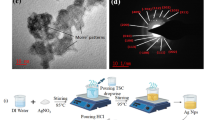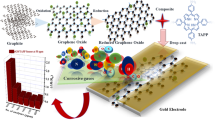Abstract
The present study shows the synthesis and characterization of graphene oxide (GO) and its composite with boric acid (GO-HBO). Their films were applied to a multi-frequency impedimetric single-sensor olfaction, operating in a high humid environment for human breath diagnoses. The characterization of the composite GO-HBO and bare GO was carried using scanning electronic microscopy (SEM), impedance spectroscopy (IS), structural analysis: XRD, Raman, and elementary analysis: X-ray photoelectron spectroscopy (XPS) and thermogravimetry (TG). The determination of the electronic signatures of the water and aqueous solutions of ethanol or acetone, in the range of 80–640 ppm, was carried out. For that, a single sensor was interrogated sequentially with five different frequencies of the signal probe, inside a headspace system. The matrix of values, of the impedance, capacitance, and phase angle, was analyzed using multivariate PCA statistics. The differential performance of both materials was discussed based on structural and electric properties. Despite the proof-of-concept nature of this study, the whole of its results contributes to the further developments of materials for single-sensor olfaction.









Similar content being viewed by others
References
R.W. Moncrieff, An instrument for measuring and classifying odors. J. Appl. Physiol. 16(4), 742–749 (1961)
J.W. Gardner, P.N. Bartlett, A brief history of electronic noses. Sens. Actuators B 18(1–3), 210–211 (1994)
J. Goschnick, M. Harms, in Detection of Explosives and Landmines, ed. by H. Schubert, A. Kuznetsov (Springer, Dordrecht, 2002), p. 83
S. Dragonieri et al., An electronic nose distinguishes exhaled breath of patients with malignant pleural mesothelioma from controls. Lung Cancer 75(3), 326–331 (2012)
M.R. Cavallari et al., A hybrid electronic nose and tongue for the detection of ketones: improved sensor orthogonality using graphene oxide-based detectors. IEEE Sens. J. 17(7), 1971–1980 (2017)
G. Gaál et al., 3D printed e-tongue. Front. Chem. 6, 151 (2018)
K. Sothivelr et al., Obtaining chemical selectivity from a single, nonselective sensing film: two-stage adaptive estimation scheme with multiparameter measurement to quantify mixture components and interferents. ACS Sens. 3(9), 1656–1665 (2018)
R.S. Andre et al., Enhanced and selective ammonia detection using In2O3/reduced graphene oxide hybrid nanofibers. Appl. Surf. Sci. 473, 133–140 (2019)
R. Bhujel, S. Rai, B.P. Swain, Investigation of cyclic voltammetry, impedance spectroscopy and electrical properties of thermally exfoliated biomass-synthesized graphene. Appl. Nanosci. 9, 1–13 (2019)
P. Ramesh, B. Jebasingh, A facile synthesis of bis-(pththalimidoethyl)-amine functionalized graphene oxide and its dual performance as a supercapacitor electrode and fluorescence sensor. Mater. Chem. Phys. 222, 45–54 (2019)
https://www.sensigent.com/products/cyranose.html, Accessed 7 March 2019
Medical Applications of Nanocomposite Sensor Arrays, https://www.sensigent.com/products/Medical%2520Applications.pdf. Accessed 7 March 2019
F. Villa et al., Wearable multi-frequency and multi-segment bioelectrical impedance spectroscopy for unobtrusively tracking body fluid shifts during physical activity in real-field applications: a preliminary study. Sensors 16(5), 673 (2016)
R. Basak, K. Wahid, A. Dinh, Determination of leaf nitrogen concentrations using electrical impedance spectroscopy in multiple crops. Remote Sens. 12(3), 566 (2020)
J.K. Brunner, P.O. Gaggero, N. Robitaille, Sensor device for electrical impedance tomography imaging, electrical impedance tomography imaging instrument and electrical impedance tomography method. U.S. Patent n. 10,548,484, 4 fev. 2020.
S. Vasantham et al., Paper based point of care immunosensor for the impedimetric detection of cardiac troponin I biomarker. Biomed. Microdevices 22(1), 6 (2020)
M.H. Amrani, P.A. Payne, K.C. Persaud, Multi-frequency measurements of organic conducting polymers for sensing of gases and vapours. Sens. Actuators B 33(1–3), 137–141 (1996)
C.M. Bhatt, N. Jampana, Multi frequency interrogation of polypyrrole based gas sensors for organic vapors. Microsyst. Technol. 17(3), 417–423 (2011)
F.S. Fedorov et al., Potassium polytitanate gas-sensor study by impedance spectroscopy. Anal. Chim. Acta 897, 81–86 (2015)
S. Borini et al., Ultrafast graphene oxide humidity sensors. ACS Nano 7(12), 11166–11173 (2013)
J.N. Appaturi et al., Supported cobalt nanoparticles on graphene oxide/mesoporous silica for oxidation of phenol and electrochemical detection of H2O2 and Salmonella spp. Mater. Chem. Phys. 232, 493–505 (2019)
F. Ejehi et al., Graphene oxide papers in nanogenerators for self-powered humidity sensing by finger tapping. Sci. Rep. 10(1), 1–11 (2020)
H. Bi et al., Ultrahigh humidity sensitivity of graphene oxide. Sci. Rep. 3(1), 1–7 (2013)
N. Li et al., Ultrahigh humidity sensitivity of graphene oxide combined with Ag nanoparticles. Rsc Adv. 7(73), 45988–45996 (2017)
F. Mouhat, F.X. Coudert, M.L. Bocquet, Structure and chemistry of graphene oxide in liquid water from first principles. Nat. Commun. 11(1), 1–9 (2020)
S. Karthick et al., Standardization, calibration, and evaluation of tantalum-nano rGO-SnO2 composite as a possible candidate material in humidity sensors. Sensors 16(12), 2079 (2016)
E. Comini, et al. GO/2D WS2 based humidity sensor. In: Multidisciplinary digital publishing institute proceedings. 2017. p. 469 (2017). https://doi.org/10.3390/proceedings1040469
G. Eda, M. Chhowalla, Chemically derived graphene oxide: towards large-area thin-film electronics and optoelectronics. Adv. Mater. 22(22), 2392–2415 (2010)
M.F.P. Da Silva et al., A simple visible light photo-assisted method for assembling and curing multilayer GO thin films. Mater. Chem. Phys. 165, 125–133 (2015)
J. Zhang, X. Zheng, Y. Ni, Selective enrichment and MALDI-TOF MS analysis of small molecule compounds with vicinal diols by boric acid-functionalized graphene oxide. J. Am. Soc. Mass Spectrom. 26(8), 1291–1298 (2015)
L. Xuyang, P. Bandyopadhyay, M. Guo, N.H. Kim, J.H. Lee, Enhanced gas barrier and anticorrosion performance of boric acid induced cross-linked poly (vinyl alcohol-co-ethylene)/graphene oxide film. Carbon 133, 150–161 (2018)
R. Li et al., Boron/nitrogen co-doped carbon synthesized from waterborne polyurethane and graphene oxide composite for supercapacitors. RSC Adv. 9(3), 1679–1689 (2019)
P. Bodian et al., Multifunctional flexible and stretchable polyurethane/carbon nanotube strain sensor for human breath monitoring. Polym. Adv. Technol. (2019). https://doi.org/10.1002/pat.4621
K.D. Singh et al., Standardization procedures for real-time breath analysis by secondary electrospray ionization high-resolution mass spectrometry. Anal. Bioanal. Chem. 411, 1–16 (2019)
T. Bruderer et al., On-line analysis of exhaled breath: focus review. Chem. Rev. 119, 19 (2019)
P. Srinivasan et al., Development of an acetone sensor using nanostructured CO3O4 thin films for exhaled breath analysis. RSC Adv. 9(52), 30226–30239 (2019)
M. Tannarana et al., Humidity sensor based on Sb0.1Sn0.9Se2 ternary alloy for human breath monitoring and touchless positioning interface. Eur. Phys. J. Plus 134(5), 211 (2019)
L. Staudenmaier, Verfahren zur darstellung der graphitsäure. Ber. Dtsch. Chem. Ges. 31(2), 1481–1487 (1898)
S. Doniach, M. Sunjic, Many-electron singularity in X-ray photoemission and X-ray line spectra from metals. J. Phys. C 3(2), 285 (1970)
D.A. Shirley, High-resolution X-ray photoemission spectrum of the valence bands of gold. Phys. Rev. B 5(12), 4709 (1972)
J.E.B. Andles, Kinetics of rapid electrode reactions. Discuss. Faraday Soc. 1, 11–19 (1947)
P. Choi, N.H. Jalani, R. Datta, Thermodynamics and proton transport in nafion: II. Proton diffusion mechanisms and conductivity. J. Electrochem. Soc. 152(3), E123 (2005)
R.N. Vyas, K. Li, B. Wang, Modifying randles circuit for analysis of polyoxometalate layer-by-layer films. J. Phys. Chem. B 114(48), 15818–15824 (2010)
MICROSOFT EXEL XLSTAT Microsoft Corporation, 2017.
M.F.P. da Silva et al., Synthesis and characterization of CeO2–graphene composite. J. Therm. Anal. Calorim. 107(1), 257–263 (2012)
P. Cui et al., One-pot reduction of graphene oxide at subzero temperatures. Chem. Commun. 47(45), 12370–12372 (2011)
F.T. Johra, J.-W. Lee, W.-G. Jung, Facile and safe graphene preparation on solution based platform. J. Ind. Eng. Chem. 20(5), 2883–2887 (2014)
M. Gönen, in Physical Chemistry for Engineering and Applied Sciences, ed. by A.K. Haghi, C.N.A. Gonzalez, S.Thomas, K.M. Praveen (Apple Academic Press, New York, 2018), p. 47
B.D. Cullity, Elements of X-Ray Diffraction, 2nd edn. (Addison Wesley, Reading, MA, USA), pp. 81–106 (1978)
A.W. Burton, O. Kenneth, R. Thomas, I.Y. Chan, Microporous Mesoporous Mater. 117, 75–90 (2009)
V. Uvarov, I. Popov, Mater. Charac. 85, 111 (2013)
L.G. Cançado et al., General equation for the determination of the crystallite size L a of nanographite by Raman spectroscopy. Appl. Phys. Lett. 88(16), 163106 (2006)
S. Islam, S.S.Z. Ashraf, Point and space groups of graphene. Resonance 24(4), 445–457 (2019)
A.C. Ferrari et al., Raman spectrum of graphene and graphene layers. Phys. Rev. Lett. 97(18), 187401 (2006)
D. Graf et al., Spatially resolved Raman spectroscopy of single-and few-layer graphene. Nano Lett. 7(2), 238–242 (2007)
L.G. Cançado et al., Quantifying defects in graphene via Raman spectroscopy at different excitation energies. Nano Lett. 11(8), 3190–3319 (2011)
D. Yang et al., Chemical analysis of graphene oxide films after heat and chemical treatments by X-ray photoelectron and Micro-Raman spectroscopy. Carbon 47(1), 145–152 (2009)
A. Kaniyoor, S. Ramaprabhu, A Raman spectroscopic investigation of graphite oxide derived graphene. AIP Adv. 2(3), 032183 (2012)
W.-K. Oh et al., Fluorescent boronic acid-modified polymer nanoparticles for enantioselective monosaccharide detection. Anal. Methods 4(4), 913–918 (2012)
X. Li et al., Enhanced gas barrier and anticorrosion performance of boric acid induced cross-linked poly (vinyl alcohol-co-ethylene)/graphene oxide film. Carbon 133, 150–161 (2018)
D.M. Patil, G.A. Phalak, S.T. Mhakse, Boron-containing UV-curable oligomer-based linseed oil as flame-retardant coatings: synthesis and characterization. Iran. Polym. J. 27(10), 795–806 (2018)
Y. Yao et al., The effect of ambient humidity on the electrical properties of graphene oxide films. Nanoscale Res. Lett. 7(1), 1–7 (2012)
N. Agmon, The grotthuss mechanism. Chem. Phys. Lett. 244(5–6), 456–462 (1995)
S. Skale, V. Doleček, M. Slemnik, Substitution of the constant phase element by Warburg impedance for protective coatings. Corros. Sci. 49(3), 1045–1055 (2007)
W. Yu et al., Significant thermal conductivity enhancement for nanofluids containing graphene nanosheets. Phys. Lett. A 375(10), 1323–1328 (2011)
N. Wei, X. Peng, Z. Xu, Understanding water permeation in graphene oxide membranes. ACS Appl. Mater. Interfaces. 6(8), 5877–5883 (2014)
P.B. de Macedo, H. Hojaji, I. S. Muller. Method for vitrifying ash. U.S. Patent n. 5,430,236, 4 Jul. 1995.x
Author information
Authors and Affiliations
Corresponding author
Additional information
Publisher's Note
Springer Nature remains neutral with regard to jurisdictional claims in published maps and institutional affiliations.
Rights and permissions
About this article
Cite this article
da Silva, M.F.P., Souza, E.J.P., Junior, A.T.S. et al. Synthesis and characterization of GO-H3BO3 composite for improving single-sensor impedimetric olfaction. J Mater Sci: Mater Electron 31, 14443–14453 (2020). https://doi.org/10.1007/s10854-020-04004-3
Received:
Accepted:
Published:
Issue Date:
DOI: https://doi.org/10.1007/s10854-020-04004-3




